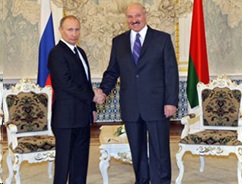However, Belarus’s leader upsets Vladimir Putin by cosying up to the West
Minsk, Jan.13.– A giant statue of Lenin still stands before the forbidding House of Government in Minsk, built by Stalin in 1934 and occupied by the Gestapo a few  years later. But behind this totalitarian façade now sits a government that is trying to work out how to reform Belarus’s economy while following a political trajectory set a quarter-century ago by the country’s authoritarian leader, Alexander Lukashenko. Now he must also fend off Russia’s looming threats to its independence. This is not an easy circle to square. But Mr Lukashenko is no ordinary politician.
years later. But behind this totalitarian façade now sits a government that is trying to work out how to reform Belarus’s economy while following a political trajectory set a quarter-century ago by the country’s authoritarian leader, Alexander Lukashenko. Now he must also fend off Russia’s looming threats to its independence. This is not an easy circle to square. But Mr Lukashenko is no ordinary politician.
A former collective-farm boss, Mr Lukashenko was swept to power in a landslide in 1994, three years after the collapse of the Soviet Union. He has ruled Belarus ever since, making him Europe’s longest-serving president. Unlike his peers in other European former Soviet republics, who rejected the old system as they asserted independence, he cherished the Soviet legacy.
Belarus still marks the Great October Revolution of 1917 with a public holiday. And Mr Lukashenko’s adherence to socialism goes well beyond symbols. Unlike his neighbours, Mr Lukashenko never embraced free markets and democracy, or privatised Belarus’s state factories. Instead, he guarantees full employment, at the cost of stifling productivity.
Belarus has no oligarchs, relatively little everyday corruption and some of the lowest rates of inequality and of people who live on less than $5 a day in the former Soviet empire. Again borrowing from Lenin’s lexicon, Mr Lukashenko consolidated power by coercion, jailing rivals and journalists, disbanding protests and earning Western sanctions and a reputation as “Europe’s last dictator”. Still, he has retained broad domestic support by keeping up adequate living standards, a sense of social justice and decent public infrastructure ...
[ Full text ]
Comments powered by CComment